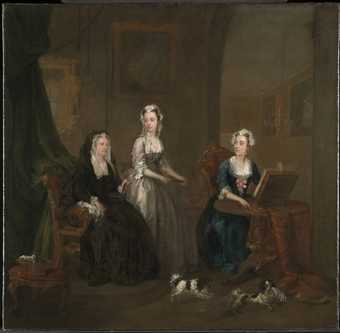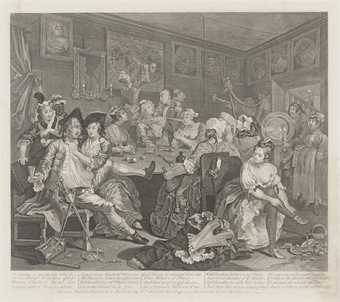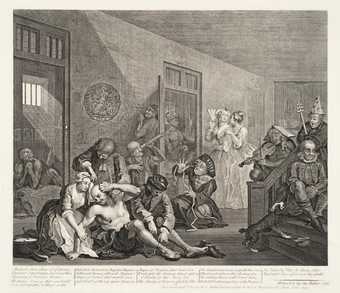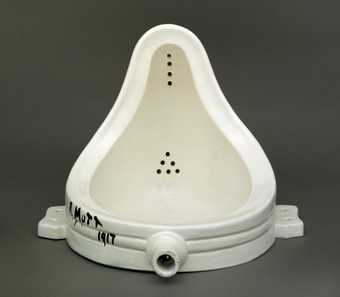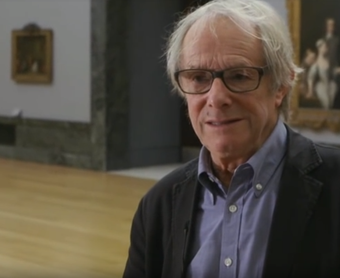You can explore the Hogarth and Europe exhibition room by room by reading the texts on this page. You can also find about more about Hogarth, his contemporaries, and the visual culture of eighteenth century Europe with our exhibition audio guide.
The audio guide includes commentary from the exhibition curators, as well as contributors Sonia E. Barrett, Zirwat Chowdhury, Janet Couloute, Raimi Gbadamosi and Lars Tharp.
Please use headphones in the gallery.
Uncovering city life
This exhibition showcases works by the eighteenth-century English artist William Hogarth. His satirical, and sometimes scandalous images of London life have been enduringly popular. Here, they are shown alongside paintings and graphic works that illuminate the many ways his art connected with the wider world.
Also on display are works by other artists, mainly Hogarth’s contemporaries in France, Italy and the Netherlands. These artists are all usually only considered in their separate national contexts.
In a period of rapid economic growth and profound social change, many European artists enjoyed new creative freedoms. They explored new modes of working, engaged new audiences and represented everyday experience in novel ways. Scenes of urban life by Hogarth and his contemporaries may appear liberated and socially relevant. Some of these images may still be funny and engaging today. Others might even appear subversive. But this exhibition confronts the complexity and violence that were features of eighteenth-century culture too. Works shown here often express a critical view of society, but they also reveal the entrenchment of racist, sexist and xenophobic stereotypes. Artists may have celebrated individuality, but they also made representations of people that are disturbing or dehumanising. This exhibition explores and critiques these images, connecting them to a larger history of social and cultural change.
Modern painters
European society and culture changed dramatically in the middle decades of the eighteenth century. In Britain, Hogarth produced images that seemed to capture all the dynamism, peril and unpredictability of present-day experience. Across Europe, artists were similarly creating images of modern life and aspiring to new roles as independent social commentators.
After a century of conflict and war, this was a period of relative peace, political stability and economic prosperity in much of Europe. Luxuries that were previously exclusive to the wealthy – including visual art, often in the form of prints – now became far more accessible. This was especially true among the growing middle classes of merchants and professionals. Images proliferated in the shops and markets of the main cities. Theatre and music flourished, there were new places to meet and be seen, and new ideas about family life. The formality and rigidity of older social hierarchies appeared to be crumbling.
This was an age of intellectual experimentation and innovation, but also materialism, moral uneasiness and hypocrisy. Yet the sense of progress, the ideals of liberty and politeness that many Europeans imagined characterised the era, were far from universal. These Enlightenment ideas were mainly produced by, and benefited, white men from the middle and upper classes. The concept of European superiority deepened, entrenching ideas about nation, personal identity and racial difference, manifested in the horrors of transatlantic slavery. Artists gave these supposed differences enduring visual form.
Artists and cities
The four large maps displayed in this room show London, Paris, Venice, and Amsterdam in the mid-1700s. The sheer size of these maps evokes the scale and complexity of the growing cities. Assembled from multiple printed sheets, they also demonstrate the flourishing art of engraving and the proliferation of prints as highly mobile commodities. Symbolic details allude to the wider world, the networks of empire and exchange that connected in these cities. While physical travel remained time-consuming and even dangerous, the thriving trade in printed materials meant that the world beyond most people’s immediate experience could appear more readily accessible. This included other cities, countries, and regions that were invaded and exploited by Europeans.
Most of the artists included in this exhibition were based in one or other of these European cities. Many visited or lived in several of these urban centres over the course of their careers, travelling to find work and new opportunities. The city became a major subject in art for the first time. Street scenes and urban views showed buildings, working life, and social encounters that might be deemed thrilling, funny, or even threatening.
Modern moral narratives
The early 1700s saw the emergence of a new kind of story-telling painting across Europe. While this drew upon seventeenth-century Dutch and Italian paintings of everyday life, it was novel in the way it set out more elaborate narratives based on contemporary experience. Artists tackled urban themes with a startling frankness, following the adventures or misadventures of individual characters and creating brazen images of drunkenness and depravity. A particularly important innovation was telling these narratives over a sequence or series of images. Such stories were intended to engage and entertain the growing metropolitan audience for art.
The Italian painter Giuseppe Maria Crespi created innovative single images of everyday life and an influential series on the dramatic ups and downs of a female opera singer. In England, Hogarth’s ‘modern moral subjects’ (as he called them) presented stories and characters of his own invention but which spoke to contemporaneous social types and preoccupations. While revealing all the temptations of the modern city, Hogarth’s series also offered distinct moral lessons about the dangers of disrupting the social order.
Reproduced and distributed as engraved prints, these innovative works became internationally famous and enormously influential. Hogarth produced his own prints after the paintings, boldly cutting out the publishers who normally profited from engravers’ works. Even so, they were widely copied and plagiarised. These series represent Hogarth as an archetypal artist-entrepreneur, creating urban narratives that directly addressed a modern public.
A Harlot's Progress
Over a series of six paintings (destroyed by fire in 1755), a story of lost innocence, cynicism and tragic decline unfolds through the figure of Moll Hackabout. In the first scene Moll arrives from the countryside, only to be drawn into life as a sex worker. She becomes the mistress of a stereotyped Jewish merchant, enjoying a life of luxury and indulging in other love affairs. But her situation steadily deteriorates: she ends up in prison, and dies a sorry death. Moll’s funeral is attended by people demonstrating various shades of indifference, cynicism or self-interest. Her fate becomes an indictment of the heartlessness of eighteenth-century society. Throughout Hogarth’s work, sex is another form of social currency, but here he associates female sexuality and sex work with
moral decline.
A Rake's Progress
Over eight pictures, Hogarth traces a moral tale of masculine waywardness and debauchery, weaving together recognisable London sites and social types. The role of the ‘Rake’ (the social type of a reckless, amoral male spendthrift) is taken by Tom Rakewell, a merchant’s son who squanders his fortune mimicking an aristocratic lifestyle which is not his ‘birth right’. Although finding a short reprieve through marriage to a wealthy bride, Tom still ends up in debtors’ prison and, finally, Bedlam hospital. Here, his mental breakdown becomes a cruel spectacle for supposedly respectable visitors. Despite Hogarth’s critical stance towards materialism and his exposure of the pretensions of polite society, in scenes 3 and 4 especially the painted luxurious surfaces are reminiscent of contemporaneous French painting.
In the company of men
The raucous humour, visual excitement and apparently subversive tone of Hogarth’s narrative pictures have attracted huge admiration over the centuries. While catering to eighteenth-century male tastes, his pictures have often been located at the beginning of a modern tradition of social criticism in art. ‘Hogarthian’ was a term in use even during the artist’s lifetime, suggesting an all-encompassing worldview: satirical, independent and insightful.
This flattering interpretation of the Hogarthian perspective helped attract clients for his portrait practice. This is perhaps surprising, as his likenesses could be disarmingly frank, including elements of unconventional behaviour or appearance.
Sometimes this involves relatively gentle humour: a portly frame or spindly legs, signs of aging beneath fancy headdresses and fine silks. Among male subjects, this quirkiness could become outrageous, even blasphemous. Occasionally the intention appears to have been satirical, but far more often the sitters were in on the joke – what might be considered ‘laddish’ humour today. It flattered men who saw themselves as free-thinking, humorous, and unconventional. The irony is that for men to tolerate such rough treatment – being cast as odd, eccentric or disreputable – they needed to enjoy a degree of power, status and stability.
Questioning Hogarth
Hogarth has been acclaimed as a subversive social critic. But he often seems opposed to social change – later in life he outspokenly supported the government and he hankered after the position of painter to the King. Some aspects of his work, such as the sexual violence, antisemitism and racism, are also often overlooked.
The explicitly racist print The Discovery is rarely acknowledged as part of Hogarth’s canon. It appears that Hogarth made the engraving in 1743 for the private amusement of a small group of his friends, and it includes recognisable portraits. Hogarth’s lost painting of A Midnight Modern Conversation has, by contrast, achieved iconic status as an image of comically outrageous male conviviality. It has been copied, reproduced, and emulated multiple times in a range of media.
A copy of A Midnight Modern Conversation is shown here alongside a derivation painted by the North American artist John Greenwood. The elements of exploitation and subjection latent in Hogarth’s image are brought to the surface in Greenwood’s work and far more easily seen. Although certainly not Greenwood’s intention, the picture exposes the stark inequities that underpinned the production of the tobacco, coffee and sugar widely consumed in Europe. The picture might be disregarded as merely an offensive colonial variation on an authentic and far more appealing Hogarthian type. But perhaps, too, the Hogarthian point of view should also be questioned?
Hidden histories
While the global histories of some artworks in this exhibition are more readily apparent, there are many more where these connections and associations are not immediately obvious, or are even hidden.
Often it is the vividly rendered material luxuries that reflect the expanding networks of trade and exploitation, be that through tea, coffee, rum or sugar, porcelain, china or mahogany. Art itself was also a material luxury with its own wealthy patrons and collectors, many of whom benefited from a culture based on commerce and colonial exploitation. Hogarth’s Southwark Fair, painted for Mary Edwards, was subsequently owned by William Atherton, who joint-owned two plantations in Jamaica and lived there until 1783, retiring to Prescot in Lancashire in 1787. Both Hogarth’s painted series, A Harlot’s Progress and A Rake’s Progress, were bought at auction by William Beckford of Fonthill. Beckford’s family were powerful plantation-owners in Jamaica and his own extensive estates amounted to 22,021 acres of land. At his death in 1770 he owned 1,356 enslaved people.
High Life
The theatres, marketplaces and pleasure gardens of the eighteenth-century city created opportunities for the classes and sexes to mix as never before. In these public and semi-public spaces there was a more fluid sense of identity than had prevailed within the rituals and physical divisions of the old, aristocratic world. Visual representations blurred the distinctions between performance and reality. An exchange of glances, a seemingly knowing pet, or a still-life detail could suggest sub-texts and ironies. The delicious handling of paint and evocation of rich textiles and consumables – the glittering ceramics, silver and exposed flesh – sought to engage the senses and suggest ironic interpretations.
In France, Jean-Antoine Watteau developed the fête galante genre – genteel garden or parkland scenes characterised by the suggestive interplay of reality and fantasy, the theatrical and the everyday. This seemingly light-hearted imagery became highly influential around Europe, as artists and artworks travelled. Hogarth’s narrative series Marriage A-la-Mode self-consciously evokes French art and style. But his is a hard-hitting story of greed, self-delusion and immorality.
The elements of erotic play and satire in eighteenthcentury images of high life underpinned a generally flattering self-image for Europe’s wealthy classes. But as Hogarth’s pictures reveal, there were also fault-lines that could contradict the claims to enlightenment and glamour, exposing tenser relationships that might, at times, even tip into violence.
Marriage A-la-Mode
Hogarth advertised this series in 1743, promising the pictures would be engraved by ‘the best Masters in Paris’ and travelled to France himself to secure their services. The six paintings follow the story of young Lord Squanderfield and his unnamed wife, the daughter of a wealthy city merchant. The first scene begins with the marriage settlement, arranged by their fathers, who trade money for status. Soon adopting a flamboyant aristocratic lifestyle, the pictures set out in excruciating detail the couple’s extravagance, self-delusion, infidelities and downfall (ending in murder and a despairing act of suicide). In contrast to the tragic content, the painted style is emphatically French, evoking the colour, glitter and sensuality of contemporary paintings of fashionable life. In this, Hogarth’s style of painting seems a parody of the narrative, lampooning fashionable tastes.
The new Europeans
Portrait painting was the most dependable source of income for artists across eighteenth-century Europe. It had traditionally required the support of the state, monarchy and aristocracy, who could afford to pay for flattering self-images. But as the century progressed, a wider range of people commissioned portraits and the character of portraiture changed. Instead of the rigid hierarchies of status and the stiff poses of earlier portraiture, there was now an emphasis on individuality, informality and ease. Hogarth was an innovator of the ‘conversation piece’, a form of smaller-scale domestic portraiture, and became known for the apparent honesty and directness of his likenesses.
The artworks across the exhibition by Hogarth and others expose the emergence of new ideas about society and the individual. They do so in the way they show cities and communities, in the stories they tell and the social types they present. The images assembled in this final room bring greater focus onto historical individuals. In their frank expressions, casual poses and apparent realism, many of these images seem to address us directly across the centuries. In this, they reflect the new sense of personal freedom and individuality that emerged in the mid-eighteenth century, and which remains familiar today. But sometimes, where these images suggest subjectivities rejected or compromised by the dominant ideas about race, class and gender, they hint at the unfulfilled promises and contradictions of modern European society.

